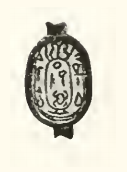Kamose
It is thought that his mother, as regent, continued the campaigns after the death of Kamose, and that his full brother made the final conquest of them and united all of Egypt.
Originally, the Theban Seventeenth dynasty rulers were at peace with the Hyksos kingdom to their north prior to the reign of Seqenenre Tao.
"[11]There is no evidence to support Pierre Montet's assertion that Kamose's move against the Hyksos was sponsored by the priesthood of Amun as an attack against the Seth-worshippers in the north (i.e., a religious motive for the war of liberation).
Because it does not mention Memphis or other major cities to the north, it has long been suspected that Kamose never did attack Avaris, but instead recorded what he intended to do.
Kamose then sailed southward, back up the Nile to Thebes, for a joyous victory celebration after his military success against the Hyksos in pushing the boundaries of his kingdom northward from Cusae past Hermopolis through to Sako, which now formed the new frontier between the seventeenth dynasty of Thebes and the fifteenth dynasty Hyksos state.
[16] The Second Stela of Kamose is well known for recounting that a Hyksos messenger was captured with a letter from Apophis—appealing for aid from the king of Kush against Kamose—while travelling through the western desert roads to Nubia.
Atfih, hence, formed either the new border or a no-man's land between the now shrunken Hyksos kingdom and Kamose's expanding seventeenth dynasty state.
Furthermore, Kamose states in his second stele that his intention in returning the letter was for the Hyksos messenger to inform Apophis of the Theban king's victories "in the area of Cynopolis which used to be in his possession.
It is unlikely that Kamose had the resources to simultaneously defeat the Kushites to the south and then inflict a serious setback on the Hyksos to the north in just one year over a front-line that extended over several hundred kilometres.
[22] Donald Redford notes that Kamose was buried very modestly, in an ungilded stock coffin which lacked even a royal uraeus.
[23] This may imply that the king died before he had enough time to complete his burial equipment presumably because he was engaged in warfare with his Kushite and Hyksos neighbours.
The mummy of Kamose is mentioned in the Abbott Papyrus, which records an investigation into tomb robberies during the reign of Ramesses IX, about 400 years after Ahmose's interment.
While his tomb was mentioned as being "in a good state",[24] it is clear that his mummy was moved at some point afterward, as it was discovered in 1857 at Dra' Abu el-Naga', seemingly deliberately hidden in a pile of debris.
The painted and stuccoed coffin was uncovered by early Egyptologists Auguste Mariette and Heinrich Brugsch, who noted that the mummy was in very poor shape.
Buried with the mummy was a gold and silver dagger, amulets, a scarab, a bronze mirror, and a pectoral in the shape of a cartouche bearing the name of his successor and brother, Ahmose.
The name of the pharaoh inscribed on the coffin was only recognized fifty years after the original discovery, by which time the mummy, which had been left with the pile of debris on which it was found, was almost certainly long lost.



